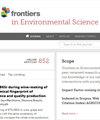用于预测二氧化碳排放量的新离散分数累积灰色贡珀兹模型
IF 3.3
3区 环境科学与生态学
Q2 ENVIRONMENTAL SCIENCES
引用次数: 0
摘要
预测二氧化碳排放量对于应对气候变化和实现环境可持续性至关重要。准确的排放预测为政策制定者提供了评估政策有效性的依据,促进了减排战略的设计和实施,并帮助企业调整运营以适应市场变化。统计模型、机器学习和灰色预测模型等各种方法已被广泛应用于二氧化碳排放预测。然而,现有研究往往缺乏与其他预测技术的对比分析。本文基于灰色系统理论,构建了一种新的离散分数累积灰色贡珀兹模型(DFAGGM(1,1)),并提供了详细的求解过程。该模型采用鲸鱼优化算法(WOA)求超参数。通过与五个基准模型的比较,验证了 DFAGGM(1,1) 预测中国和美国二氧化碳排放数据的有效性。本文章由计算机程序翻译,如有差异,请以英文原文为准。
New discrete fractional accumulation Grey Gompertz model for predicting carbon dioxide emissions
Predicting carbon dioxide emissions is crucial for addressing climate change and achieving environmental sustainability. Accurate emission forecasts provide policymakers with a basis for evaluating the effectiveness of policies, facilitating the design and implementation of emission reduction strategies, and helping businesses adjust their operations to adapt to market changes. Various methods, such as statistical models, machine learning, and grey prediction models, have been widely used in carbon dioxide emission prediction. However, existing research often lacks comparative analysis with other forecasting techniques. This paper constructs a new Discrete Fractional Accumulation Grey Gompertz Model (DFAGGM(1,1) based on grey system theory and provides a detailed solution process. The Whale Optimization Algorithm (WOA) is used to find the hyperparameters in the model. By comparing it with five benchmark models, the effectiveness of DFAGGM(1,1) in predicting carbon dioxide emissions data for China and the United States is validated.
求助全文
通过发布文献求助,成功后即可免费获取论文全文。
去求助
来源期刊

Frontiers in Environmental Science
Environmental Science-General Environmental Science
CiteScore
4.50
自引率
8.70%
发文量
2276
审稿时长
12 weeks
期刊介绍:
Our natural world is experiencing a state of rapid change unprecedented in the presence of humans. The changes affect virtually all physical, chemical and biological systems on Earth. The interaction of these systems leads to tipping points, feedbacks and amplification of effects. In virtually all cases, the causes of environmental change can be traced to human activity through either direct interventions as a consequence of pollution, or through global warming from greenhouse case emissions. Well-formulated and internationally-relevant policies to mitigate the change, or adapt to the consequences, that will ensure our ability to thrive in the coming decades are badly needed. Without proper understanding of the processes involved, and deep understanding of the likely impacts of bad decisions or inaction, the security of food, water and energy is a risk. Left unchecked shortages of these basic commodities will lead to migration, global geopolitical tension and conflict. This represents the major challenge of our time. We are the first generation to appreciate the problem and we will be judged in future by our ability to determine and take the action necessary. Appropriate knowledge of the condition of our natural world, appreciation of the changes occurring, and predictions of how the future will develop are requisite to the definition and implementation of solutions.
Frontiers in Environmental Science publishes research at the cutting edge of knowledge of our natural world and its various intersections with society. It bridges between the identification and measurement of change, comprehension of the processes responsible, and the measures needed to reduce their impact. Its aim is to assist the formulation of policies, by offering sound scientific evidence on environmental science, that will lead to a more inhabitable and sustainable world for the generations to come.
 求助内容:
求助内容: 应助结果提醒方式:
应助结果提醒方式:


